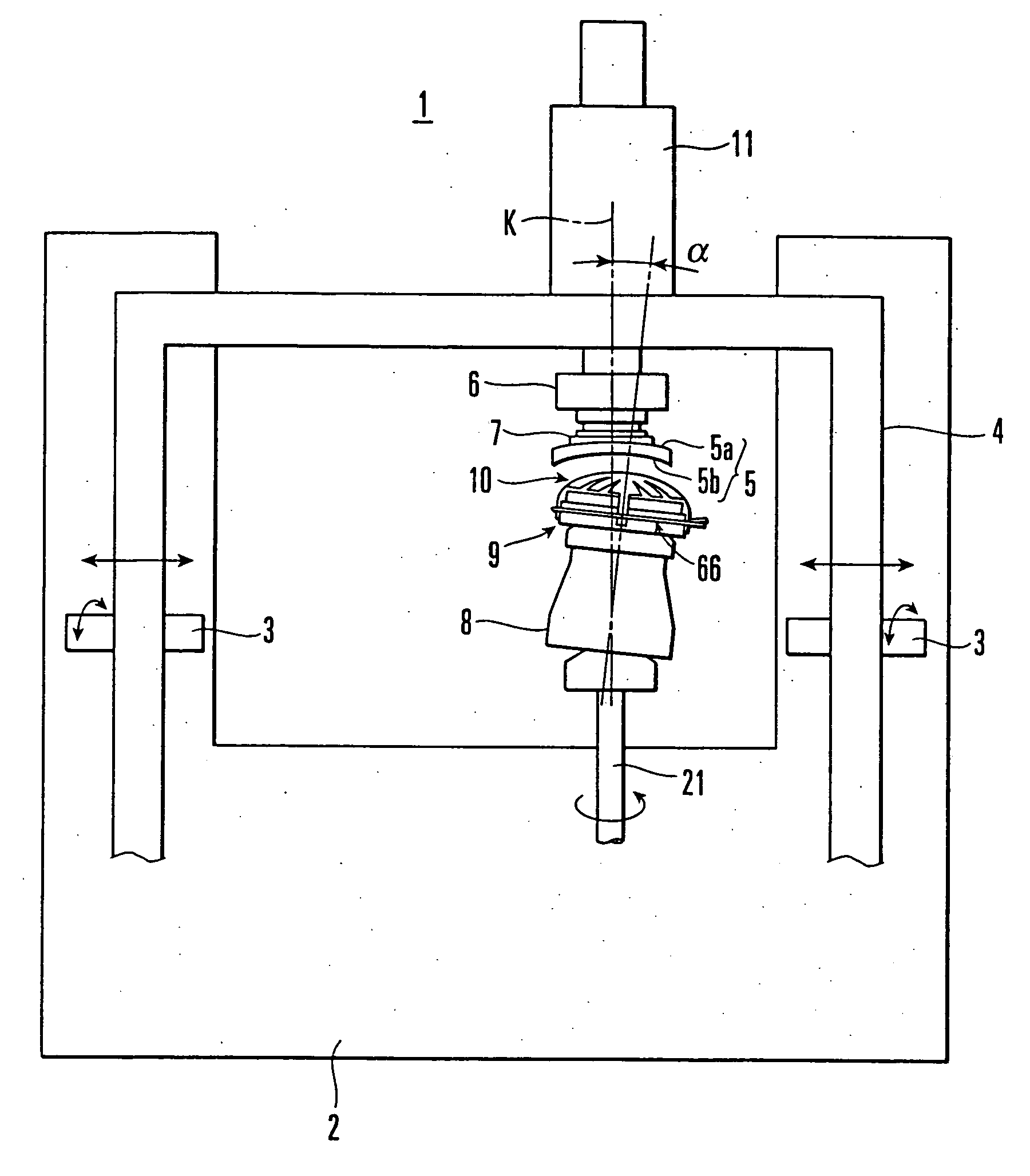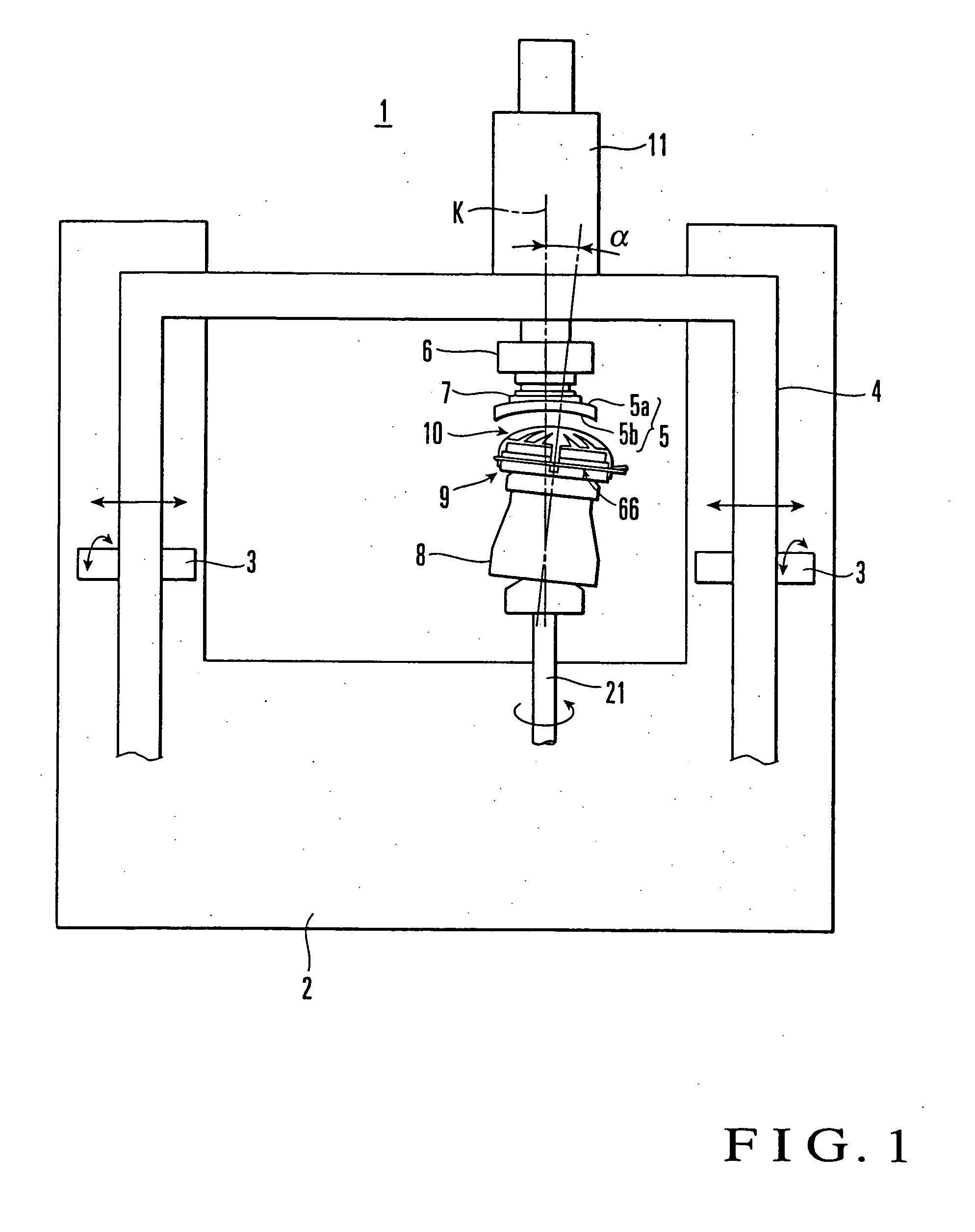Polishing apparatus
a technology of polishing jigs and jigs, which is applied in the field of polishing jigs, can solve the problems of increasing large storage space, and cumbersome management of them, and achieves the effects of improving the accuracy of finishing, and reducing the manufacturing cost of polishing jigs
- Summary
- Abstract
- Description
- Claims
- Application Information
AI Technical Summary
Benefits of technology
Problems solved by technology
Method used
Image
Examples
first embodiment
[0067]FIG. 1 shows the basic arrangement of a polishing apparatus according to the present invention. In the embodiment to be described below, the present invention is applied to a polishing apparatus which polishes, as an object to be polished, a concave surface formed from a toric surface of a plastic lens for correcting astigmatism. The lens to be polished is represented by an urethane- or epithio-based plastic lens.
[0068] Referring to FIG. 1, a spectacle lens polishing apparatus 1 comprises an apparatus main body 2 installed on the floor surface, an inverted-U-shaped arm 4 which can freely pivot in a direction perpendicular to the drawing surface about horizontal shafts 3 that are movable to the left and right on the drawing surface, a driving unit (not shown) which reciprocally moves the arm 4 to the left and right and also pivots the arm 4 in the direction perpendicular to the drawing surface, a lens attachment portion 6 which is arranged on the arm 4 to hold a convex surface...
second embodiment
[0116]FIG. 13 shows another embodiment of the present invention.
[0117] In this embodiment, a plate thickness T of a cylinder portion 25B of a balloon member 25 is set to be larger than plate thicknesses T1 and T2 of a dome portion 25A and inner flange 25C. The remaining structures are the same as in the above-described first embodiment.
[0118] In this structure, since the plate thickness T of the cylinder portion 25B is large, and the rigidity increases, the shape holding ability is high. Hence, the dome portion 25A can be stably held, and deformation or expansion / contraction of the cylinder portion 25B due to sliding friction with respect to a lens 5 can be reduced or prevented.
third embodiment
[0119]FIG. 14 shows still another embodiment of the present invention.
[0120] In this embodiment, a balloon member 25 is constructed by a dome portion 25A and cylinder portion 25B. The cylinder portion 25B has, at its rear opening edge, a tapered cylinder portion 25B-1 inclined inward. An annular lock portion 70 bent inward is integrally formed at the end of the tapered cylinder portion 25B-1. The inner flange 25C shown in FIG. 7 is omitted. In addition, an inner fixture 29 and outer fixture 30 have, as their opposing walls, tapered portions 71 and 72 inclined at the same angle as that of the tapered cylinder portion 25B-1. The inner and outer surfaces of the tapered cylinder portion 25B-1 are sandwiched between the tapered portions 71 and 72. The lock portion 70 is fitted in an annular groove 73 formed in the tapered portion 71 of the inner fixture 29, thereby closing the rear opening portion of the balloon member 25. The remaining structures are the same as in the first embodiment...
PUM
| Property | Measurement | Unit |
|---|---|---|
| thickness | aaaaa | aaaaa |
| thickness | aaaaa | aaaaa |
| heights | aaaaa | aaaaa |
Abstract
Description
Claims
Application Information
 Login to View More
Login to View More - R&D
- Intellectual Property
- Life Sciences
- Materials
- Tech Scout
- Unparalleled Data Quality
- Higher Quality Content
- 60% Fewer Hallucinations
Browse by: Latest US Patents, China's latest patents, Technical Efficacy Thesaurus, Application Domain, Technology Topic, Popular Technical Reports.
© 2025 PatSnap. All rights reserved.Legal|Privacy policy|Modern Slavery Act Transparency Statement|Sitemap|About US| Contact US: help@patsnap.com



